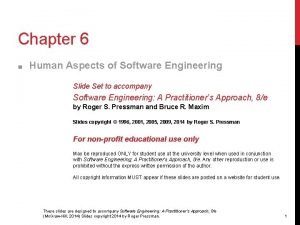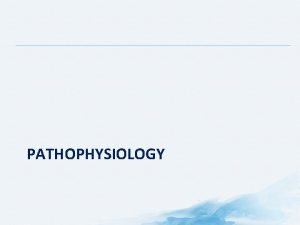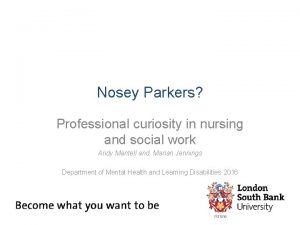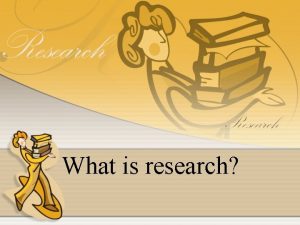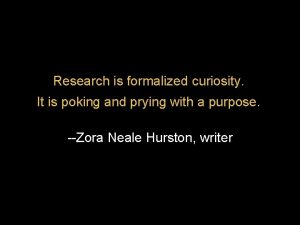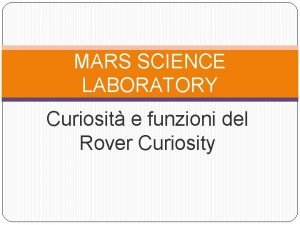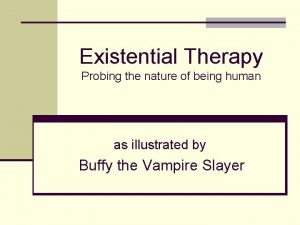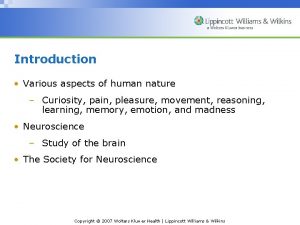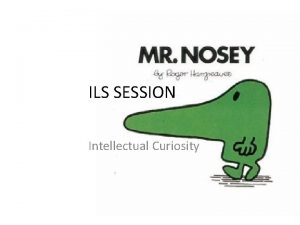Introduction Various aspects of human nature Curiosity pain
























- Slides: 24

Introduction • Various aspects of human nature – Curiosity, pain, pleasure, movement, reasoning, learning, memory, emotion, and madness • Neuroscience – Study of the brain • The Society for Neuroscience Copyright © 2007 Wolters Kluwer Health | Lippincott Williams & Wilkins

The Origins of Neuroscience • Views of the Brain: Ancient Greece – Correlation between structure and function – Hippocrates • Brain: Involved in sensation; seat of intelligence Copyright © 2007 Wolters Kluwer Health | Lippincott Williams & Wilkins

The Origins of Neuroscience • Views of the Brain: The Roman Empire – Views of Greek physician Galen: Localization of function • Cerebrum Sensation • Cerebellum Motor • Ventricles ‘Communicating’ fluids Copyright © 2007 Wolters Kluwer Health | Lippincott Williams & Wilkins

The Origins of Neuroscience • Views of the Brain: The Renaissance – Fluid-mechanical theory of brain function – Philosophical mind-brain problem Copyright © 2007 Wolters Kluwer Health | Lippincott Williams & Wilkins

The Origins of Neuroscience • Views of the Brain: The Seventeenth and Eighteenth Centuries – Gray matter and white matter Copyright © 2007 Wolters Kluwer Health | Lippincott Williams & Wilkins

The Origins of Neuroscience • Views of the Brain: Renaissance to the Nineteenth Century – Gyri, sulci, and fissures Copyright © 2007 Wolters Kluwer Health | Lippincott Williams & Wilkins

The Origins of Neuroscience • Views of the Brain: The Nineteenth Century – Central subdivision: brain and spinal cord – Peripheral division: network of nerves coursing through the body Copyright © 2007 Wolters Kluwer Health | Lippincott Williams & Wilkins

The Origins of Neuroscience • Views of the Brain: The Nineteenth Century – Nerve as wires, understanding of electrical phenomena, nervous system can generate electricity – Bell and Magendie: Dorsal and ventral roots carry information in opposite directions Copyright © 2007 Wolters Kluwer Health | Lippincott Williams & Wilkins

The Origins of Neuroscience • Localization of Function in the Brain – Charles Bell • Cerebellum: Origin of the motor fibers • Cerebrum: Destination of sensory fibers – Marie-Jean-Pierre Flourens • Experimental ablation method Copyright © 2007 Wolters Kluwer Health | Lippincott Williams & Wilkins

Localization of function from brain injury/stroke Example: Phineus Gage Copyright © 2007 Wolters Kluwer Health | Lippincott Williams & Wilkins

The Origins of Neuroscience • Localization of Function in the Brain (Cont’d) – Paul Broca • Discrete region of the human cerebrum for speech Copyright © 2007 Wolters Kluwer Health | Lippincott Williams & Wilkins

The Origins of Neuroscience • Localization of Function in the Brain – Franz Joseph Gall • Phrenology: Bumps on the surface of skull reflect brain surface and related personality traits Copyright © 2007 Wolters Kluwer Health | Lippincott Williams & Wilkins

The Origins of Neuroscience • Localization of Function in the Brain (Cont’d) – Regional specialization in different species Copyright © 2007 Wolters Kluwer Health | Lippincott Williams & Wilkins

The Origins of Neuroscience • Evolution of the Nervous System – Natural selection – Nervous systems of different species may share common mechanisms – Rationale for “animal models” Copyright © 2007 Wolters Kluwer Health | Lippincott Williams & Wilkins

The Origins of Neuroscience • The Neuron: The Basic Functional Unit of the Brain – Cell theory – Cells – Nerve cells Copyright © 2007 Wolters Kluwer Health | Lippincott Williams & Wilkins

Neuroscience Today • Reductionist approach – Levels of analysis • Molecular • Cellular • Systems • Behavioral • Cognitive Copyright © 2007 Wolters Kluwer Health | Lippincott Williams & Wilkins

Concluding Remarks • Goal of neuroscience: To learn how the nervous system functions – Brain’s activity reflected in behavior – Computer-assisted imaging techniques – New treatments for nervous system disorders – Non-invasive methods – Experiments in live tissue Copyright © 2007 Wolters Kluwer Health | Lippincott Williams & Wilkins

• End of presentation Copyright © 2007 Wolters Kluwer Health | Lippincott Williams & Wilkins

The Origins of Neuroscience • Prehistoric ancestors – Brain vital to life • Skull surgeries – Evidence: Trepanation – Skulls show signs of healing • Views of ancient Egypt – Heart: Seat of soul and memory (not the head) Copyright © 2007 Wolters Kluwer Health | Lippincott Williams & Wilkins

Copyright © 2007 Wolters Kluwer Health | Lippincott Williams & Wilkins

Neuroscience Today • The Neuroscientist -Education, Training, Research experience -Clinical vs. Experimental research Copyright © 2007 Wolters Kluwer Health | Lippincott Williams & Wilkins

Neuroscience Today • Scientific Process – Observation – Replication – Interpretation – Verification Copyright © 2007 Wolters Kluwer Health | Lippincott Williams & Wilkins

Neuroscience Today • The Use of Animals in Neuroscience Research – Animals: Renewable natural resources – The more basic the process under investigation, the more distant the evolutionary relationship with humans • Examples (from simple to more complex) nematodes, insects, snails, squid, rodents, monkeys, etc. Copyright © 2007 Wolters Kluwer Health | Lippincott Williams & Wilkins

Neuroscience Today • The Cost of Ignorance: Nervous System Disorders Copyright © 2007 Wolters Kluwer Health | Lippincott Williams & Wilkins
 Cyclical theory of social change
Cyclical theory of social change Martian pain
Martian pain What is breast tenderness in pregnancy
What is breast tenderness in pregnancy Period vs pregnancy symptoms
Period vs pregnancy symptoms Human aspects of software engineering
Human aspects of software engineering Nociception
Nociception Nature of the pain
Nature of the pain Human acts and acts of man
Human acts and acts of man A piece of gross impertinence
A piece of gross impertinence Professional curiosity
Professional curiosity Intellectual curiosity definition
Intellectual curiosity definition Research is rearranging facts
Research is rearranging facts Curiosity and the copycat
Curiosity and the copycat Natural curiosity
Natural curiosity Curiosity
Curiosity Professional curiosity 7 minute briefing
Professional curiosity 7 minute briefing Robot curiosity funzioni
Robot curiosity funzioni Maintaining curiosity
Maintaining curiosity Nature and nature's laws lay hid in night
Nature and nature's laws lay hid in night Nature nature controversy
Nature nature controversy Thomas hobbes human nature
Thomas hobbes human nature Descartes human nature
Descartes human nature Nature of nurture chapter 3
Nature of nurture chapter 3 Reality
Reality Existential therapy view of human nature
Existential therapy view of human nature




